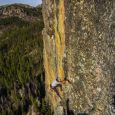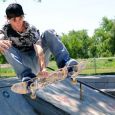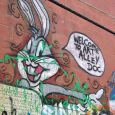The Gift of South Dakota
Subscriptions to South Dakota Magazine make great gifts!
Subscribe today — 1 year (6 issues) is just $29!
Minnilusa Links Old and New
 |
| Rapid City's Minnilusa Pioneer Museum preserves all things Western. Pictured here is former museum director Reid Riner. Photo by Johnny Sundby. |
Editor’s Note: This story is revised from the January/February 2015 issue of South Dakota Magazine. In 2017, Reid Riner left the Minnilusa and moved from Rapid City to Arizona . He passed away in a car accident near Phoenix in 2018. To order a copy or to subscribe, call (800) 456-5117.
MUSEUM OBJECTS CAN sometimes speak more powerfully than words. Stroke Doc Middleton’s saddle at the Minnilusa Pioneer Museum in Rapid City. Feel the tooling, sniff the horn and let the leather scent transplant you to the open range.
That’s the very saddle the outlaw Middlelton used an 1893 cowboy race across the prairie, from Chadron to Chicago's World Columbian Exposition. The man sure could ride, although it appears he cheated in this race and perhaps also used the saddle for cattle rustling.
Which brings up an important point. The Minnilusa collection documents the pioneer history of the Black Hills, and Rapid City especially. The western frontier drew a wide range of opportunists, most of them honorable and some anything but. To fully understand the frontier, which has been both glorified and marginalized by media professionals over the decades, it is important to let these objects speak as they will. In other words, an artifact's presence here isn't meant to say its original owner has been elevated as a role model for future generations.
That being the case, Peter Lemley's boots, hat and Winchester carbine are here. He, like Middleton, was part of the vast open range cattle business of the late 1800s, and can be ranked as one of the meanest cusses to ever walk Rapid City's streets. Lemley hated the Lakota people, was part of the civilian militia that played a role in events that led to the Wounded Knee tragedy, and it's been rumored he had his own son murdered. The son's offense? He loved animals and Lemley feared he was soft.
"But you never know what the rest of the story will be when you find someone like that in history," notes museum director Reid Riner. "Something good came out of even Lemley's story. Another son grew up to be a well-known Rapid City physician who started the Lemley Foundation. It's still supporting charitable work today."
 |
| Officers of the Sweeney Hose Company in Rapid City used this silver speaking trumpet to direct firefighters. The trumpet dates to 1888. |
Juxtaposed between the Middleton and Lemley exhibits is a photo cutout of Gus Haaser, a cattleman Riner considers a remarkably moral man. "Haaser came from Norway, and he doesn't really look like a cattleman, but he made himself into a good one," Riner says. "He wrote that he never saw the horizon in Norway, but that South Dakota was nothing but horizon."
Gold mining usually grabs most of the attention when historians discuss Black Hills pioneers, and it is represented at the Minnilusa museum. But the industry Middleton, Lemley and Haaser were part of (honorably or otherwise) was integral, too, particularly in Rapid City. "Beginning with the open range herds that came up from Texas, cattle brought in the dollars that changed Rapid City from a place of log structures to one of big stone business buildings," Riner says. Indeed, the town grew from 202 residents in 1880 to about 2,000 when South Dakota achieved statehood in 1889.
STILL, RAPID CITY got off to a rocky start in 1876. On display here is the pocket compass John Brennan used, and the surveyor's chain, when six blocks were laid out in February of that year. In the middle of that area Rufus "Pap" Madison built a little rough-hewn cabin, destined to play a big role in the Minnilusa museum's own history 50 years later. In 1876, it was amazing the cabin survived as Lakota warriors repeatedly attacked the fledgling town. They were fully justified in their outrage because Rapid City sat illegally on land set aside for the Lakota people by federal treaty. By late summer most of the town's original pioneers had fled 200 miles east to Fort Pierre.
They returned in force in 1877 when the government assured them the treaty had been changed — an issue that remains in dispute more than 140 years later. Never dreaming future generations could possibly question their right to the land, the first Rapid Citians rolled up their sleeves and built homes, businesses, Gothic Revival churches of many denominations and schools. Among the schools was an institution of higher learning, the territorial School of Mines. In the middle of this rush of construction, Grace French, a 26-year-old artist trained at Boston's School of Fine Arts, stepped off a stagecoach in 1885. French made Rapid City her home for the rest of her long life, and today the Minnilusa Pioneer Museum displays many of her paintings and sketches. Her art documents the beauty of the Black Hills before roads and other development encroached, back when Rapid City felt like a tiny village nestled in the foothills.
Grace French is just one of the artists and storytellers remembered by this museum. Others include poet Captain Jack Crawford, early photographer Jack Collins, historian Annie Tallent, and husband and wife newspaper pioneers Joseph and Alice Gossage. The Gossages made the paper known today as The Rapid City Journal into western South Dakota's premier paper, and in time Alice played a key role in launching the Minnilusa Pioneer Museum.
UNLIKE MANY HISTORICAL exhibitions across the West, the Minnilusa doesn't dwell extensively on bawdy enterprises, although it notes madam Dora DuFran ran a house of ill repute in Rapid City in addition to her Deadwood and Sturgis franchises. There's more emphasis on above-board businesses that filled those big buildings cattle money built.
 |
| Soldiers stationed at forts around Dakota Territory may have carried firearms similar to this 1877 Colt single action .45 revolver. |
"In interpreting mercantile businesses, it's effective to tell the stories of the personalities behind those stores," Riner says. And to be sure, downtown Rapid City claimed larger-than-life entrepreneurs. Cattleman Peter Duhamel's in-town job was overseeing a massive downtown store, and nearby he manufactured his famous Duhamel saddles. Tom Sweeney was a name known by everyone across western South Dakota and sizeable sections of Wyoming and Montana. That was because of signs and handbills that read simply, "Tom Sweeney Wants to See You." Once drawn into his big Rapid City store, customers weren't disappointed. They could buy everything from trousers to a freight wagon.
Sweeney didn't claim the only local slogan well known a century or more ago. "Learn to say Cyco Cigar," read old print ads, referring to a tobacco product manufactured by Rapid City's own Gate City Cigar Company. Other early merchandise that has found its way into the museum include a wicker purse, fine china and a Red Wing butter churn. Most intriguing is the museum's collection of patent medicine bottles and packaging. "People came to Rapid City from places where there were no doctors, and if there had been, they couldn't afford them," Riner says. "So they saw patent medicines as their best options for staying healthy."
Lots of those patent medicines contained alcohol, Riner adds, so customers certainly felt better after a dose or two — for a little while. It's unlikely the modern Food and Drug Administration would have seen much merit in Dr. Hobson's stimulant, described as a "wonder drug promising to 'cure while you sleep' whooping cough, croup, bronchitis, coughs, grip, hay fever, diphtheria & scarlett fever." But for ranch families living 100 miles from a doctor, knowing the "wonder drug" sat waiting in the kitchen cupboard brought comfort.
By the 1920s, Black Hills pioneers were passing away and, in too many cases, taking their stories with them. Communities suddenly took great interest in monuments, celebrations and museums that would record pioneer names and adventures. That decade Spearfish unveiled its 11-foot-tall stone "Memorial to Spearfish Pioneers, 1876 - 1926." Deadwood launched its Days of '76 festivities in 1924. In 1926 in Rapid City, Alice Gossage, the newspaper owner, put money and her considerable community clout behind an effort to repair and move Pap Madison's 1876 cabin to Halley Park, just west of downtown. "The story is she just walked into a city council meeting and said it had to happen, and so it did," Riner says.
Richard Hughes, one of the best Black Hills historians and himself an 1876 pioneer, wrote this poem inscribed on a slab outside the cabin:
Not only was the cabin a museum artifact, it became a museum itself after items collected by the recently formed Minnilusa Pioneers' Association were displayed within. "This society," wrote Hughes in the late 1920s, "organized to preserve data and relics of the early-day West River country and Black Hills area, has in its membership many descendants of pioneers." Those early members decided to use a Lakota term for their association's name, one meaning "rapid water." When translated to English it gave Rapid City its name.
 |
| This pocket watch with human hair fob was fashionable in the 1800s. Jewelry made with hair was often carried as a tribute to lost loved ones. |
While the Pap Madison cabin can be considered the Black Hills' first history museum (it predated Deadwood's Adams Museum by four years), it was also one of the smallest. For decades most of the relics collected by the association were stored in a warehouse. Beginning in the 1930s the cabin shared Halley Park with the U.S. Department of the Interior's world-class Sioux Indian Museum, a collection of Lakota artifacts placed in a new stone building built by the Works Progress Administration. In 1956 a new wing was added to that building, space that allowed the Minnilusa Association to take artifacts out of storage and into exhibits.
"In 1956, in the minds of some people, an Indian institution and a pioneer institution didn't seem to belong together," Riner says. But in Rapid City it worked, and nearly 60 years later the two museums still co-exist under one roof, although not in Halley Park. They were among four museums that remained independent yet moved into the Journey Museum complex in 1997 (the others are the South Dakota Historical Society's Research Center and City of Rapid City's Duhamel Plains Indian Artifact Collection). The Pap Madison cabin trailed behind, arriving in 2012. It stands in front of the Journey.
Riner became involved with Minnilusa in 2004. He grew up next door to Rapid City in Black Hawk, then left the state for 16 years for work and education. He earned a master’s in Public History at Arizona State. He enjoyed visiting the Journey Museum during trips home, and was ready to return to the Black Hills to stay when the Minnilusa position opened. Riner inherited a strong organization with a solid endowment and a collection that now numbers more than 6,000 artifacts, of which 30 to 35 percent are on display at any one time.
 |
| A West River cowboy made this horsehair bridle and rein set sometime in the 1880s. |
The museum is also home to a collection of 8,000 to 10,000 photographic images, most scanned into a digital format. The collection is proving itself invaluable to historians, publishers and individuals hoping to learn more about their Black Hills roots. Well-known Black Hills photographer Johnny Sundby serves on the Minnilusa board and helps manage the photos. Among his favorites are those depicting the towns of Pactola and Sheridan before reservoir waters claimed the sites, Rapid City's nearly forgotten Alfalfa Palace, mines, flume trails, Rapid City's first airplane flight in 1909, and development of Mount Rushmore and the Hotel Alex Johnson. "We're always looking for original prints people may have," Sundby says. "They can take home a cleaned-up image where scratches, discoloration and tape marks are gone."
Riner considers Rapid City's true pioneer years to have been from the 1870s until 1934 and 1935, when manned balloon flights into the stratosphere (documented well by the museum) moved Rapid City into the nation's consciousness in a new way.
But that doesn't mean the spirit of old-fashioned town-building ended at that time. In fact, Rapid City's downtown redevelopment over the past decade is unmatched regionally, resulting in Main Street Square, arts venues and new dining and retail. There's increased emphasis on pedestrian access, ways for visitors to park their cars and move through what Riner describes as an evolving "cultural campus," linking the museum to the civic center, historical district, public art and library.
"We've got the seeds for growing cultural tourism," he says, "and a city government committed to making it happen."
It's happening even without Alice Gossage barging into meetings and demanding action.
Editor’s Note: This story is revised from the January/February 2015 issue of South Dakota Magazine. To order a copy or to subscribe, call (800) 456-5117.










Comments